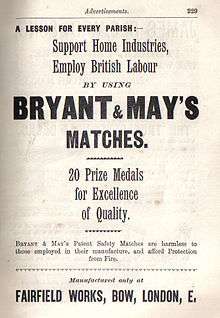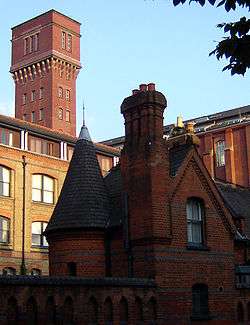Bryant and May

Bryant and May was a United Kingdom (UK) company created in the mid-nineteenth century specifically to make matches. Their original Bryant and May Factory was located in Bow, London. They later opened other match factories in the United Kingdom and Australia, such as the Bryant and May Factory, Melbourne, and owned match factories in other parts of the world.
Bryant and May survived as an independent company for over seventy years, but went through a series of mergers with other match companies and later with consumer products companies; and were taken over.
The registered trade name Bryant and May still exists and it is owned by Swedish Match, as are many of the other registered trade names of the other, formerly independent, companies within the Bryant and May group.
Formation
A partnership was formed in 1843 between two Quakers, Francis May and William Bryant, to establish a Provisions Merchants business in Tooley Street, London. In 1850 they started importing Swedish matches, produced by Carl and Johan Lundström.[1] Their first order was for 10 or 15 cases of 720,000 matches (each case held 50 gross boxes, with a box holding 100 matches). The next order was for 50 cases; and later orders for 500 cases. This partnership was successful, so Francis May and William Bryant decided to merge the partnership with Bryant's company, Bryant and James, which was based in Plymouth.[1] By 1853 Bryant and May were selling over 8 million boxes of matches per year; which was approximately 50% of the output of the Lundström brothers. By 1860 Bryant and May’s sales had risen to 27.9 million boxes.[1][2]
In 1861, at the Fairfield Works, a dilapidated site that had once been used for the manufacture of candles, crinoline and rope, close to the River Lea in Bow, they began to manufacture their own safety matches and "other chemical lights". This site was gradually expanded as a model factory. The public were initially unwilling to buy the more expensive safety matches so they also made the more profitable traditional Lucifer Matches.[2]
Bryant and May was involved in three of the most divisive industrial episodes of the nineteenth century, the sweating of domestic out-workers, the wage "fines" that led to the London matchgirls strike of 1888 and the scandal of "phossy-jaw". The strike won important improvements in working conditions and pay for the mostly female workforce working with the dangerous white phosphorus.[2]

Mergers with other match makers
To protect its position Bryant and May merged with or took over its rivals. These were:
- Bell and Black
In 1885 - factories in Stratford, Manchester, York and Glasgow.[2]
- Diamond Match
In 1901 the American match maker The Diamond Match Company bought an existing match factory in the United Kingdom, at Litherland, near Liverpool, and installed a continuous match making machine that could produce 600,000 matches per hour. Their matches were sold under the Captain Webb, Puck and Swan Vesta brand names. Bryant and May could not compete, so in 1905 they bought the assets and goodwill of the British Diamond Match Company; and the (American) Diamond Match Company acquired 54.5 percent of the share capital of Bryant and May.
- S.J.Moreland and Sons
In 1913 Bryant and May also took over the Gloucester match maker S.J. Moreland and Sons, who made and sold matches under the trade name England's Glory.
- Swedish Match
In 1927 Bryant and May combined with J. John Masters & Co. Ltd (match importers and owners of the Abbey Match Works, Barking, Essex) and the Swedish Match Company's interests in the British Empire (except for major plant in India and elsewhere in Asia) to become the British Match Corporation.[3]
- Albright and Wilson
In 1929, the British Match Corporation set up a jointly-owned company with another Quaker company Albright and Wilson: The A & W Match Phosphorus Company. It took over that part of Albright and Wilson's Oldbury site which was manufacturing amorphous phosphorus and phosphorus sesquisulfide, as these two chemicals were used in safety matches and strike-anywhere matches, respectively.[4]
Merger with Wilkinson Sword
In 1973 the British Match Corporation merged with Wilkinson Sword to form the new company Wilkinson Match.
Wilkinson Match's shares were acquired by US company Allegheny International from 1978 with Allegheny taking full ownership in 1980. In 1987 Allegheny filed for Chapter 11 bankruptcy and Swedish Match re-acquired the company. In 1990 Swedish Match sold the Wilkinson Sword business, retaining the match business.[5]
Closure
In 1971 the Northern Ireland factory, Maguire & Patterson closed down following a terrorist attack. The original Bow match factory was closed in 1979, when it still employed 275 people; unlike some of the other match factories little recent investment had taken place. The Bow factory site consisted of a number of listed buildings, which have subsequently been converted into the Bow Quarter apartment complex.[6]
In the 1980s, factories in Gloucester and Glasgow closed too leaving Liverpool as the last match factory in the UK. This continued until December 1994.[7] The premises survive today as The Matchworks (grade 2 listed building) and The Matchbox all using the existing buildings with renovations done by Urban Splash.
The former Australian match factory, in Melbourne, closed in the mid-1980s. This was converted into offices in 1989.[8]
The British match brands continue to survive as brands of Swedish Match and are made outside the UK. Other parts of the merged company involved in shaving products survive, and still use the trade name Wilkinson Sword in Europe, and the Schick trade name elsewhere. However,the shaving products are made in Germany.
Products
Vitafruit
Vitafruit was a confectionery manufactured by the Bryant & May group in 1988. There were three varieties including tropical fruit flavour (Vitafruit), mint (Vitamint) and a throat soother (Vitasooth).
When Swedish Match acquired Bryant & May the confectionery arm of the business was sold and eventually the new owners stopped production of Vitafruit.
See also
- Bryant and May Factory, Bow
- Bryant and May Factory, Melbourne
- Mersey Match Factory
- Redheads (matches)
References
Notes
- 1 2 3 Beaver (1985): Part One: "Building a Business".
- 1 2 3 4 Arnold, A.J. (2004). "'Ex luce lucellum'? Innovation, class interests and economic returns in the nineteenth century match trade" (pdf). University of Exeter. ISSN 1473-2904. Retrieved 11 October 2016.
- ↑ "J. John Masters". The National Archives. Richmond, Surrey. Retrieved 14 October 2016.
- ↑ Threfall (1951).
- ↑ Competition Commission Reports 1987: Bryant & May and Wilkinson Sword
- ↑ Building, 11 June 1993
- ↑ The Times, 23 December 1994.
- ↑ Sunday Age, 3 December 1995.
Sources
- Beaver, Patrick, (1985). The Match Makers: The Story of Bryant & May. London: Henry Melland Limited. ISBN 0-907929-11-7.
- Emsley, John (2000). The shocking history of Phosphorus: a biography of the Devil's element. London: Macmillan. ISBN 0-333-76638-5.
- Threlfall, Richard E. (1951). The Story of 100 years of Phosphorus Making 1851 - 1951, Oldbury: Albright & Wilson Limited.
- Competition Commission (1987). Bryant & May and Wilkinson Sword
External links
- "Archival material relating to Bryant and May". UK National Archives.
- https://web.archive.org/web/20071022123839/http://www.competition-commission.org.uk//rep_pub/reports/1987/fulltext/217c02.pdf